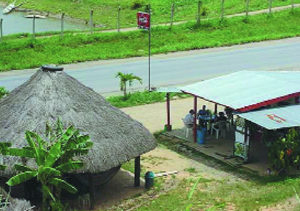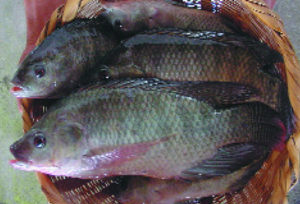Long-running programs support local, export markets

The culture of tilapia began in Honduras about 50 years ago. At that time, several development projects disseminated rudimentary fish culture techniques as a means to provide animal protein in the diets of the rural poor. During the ensuing years, numerous interventions by additional development projects, nongovernmental organizations, and local private and public agencies have contributed to making tilapia culture an important component of local agriculture systems.
Funding from international donors over many years made possible the construction of adequate infrastructure, technical training, and the realization of research programs to define and develop fish production parameters appropriate for the region. Much of the research came about from more than 20 years of assistance from the Aquaculture Collaborative Research Support Program with funding from USAID in the United States. All of these factors have contributed to making Honduras an important aquaculture-producing country.
Tilapia exports change perceptions
The export of tilapia fillets from Honduras to North America commenced in 1991, but was not sustainable. Around 1996, a large commercial fish farm began exporting fresh tilapia fillets to North American markets from northern Honduras. Several years later, a second farm began to export tilapia. The farms’ exports are summarized in Table 1.
Meyer, Quantities and values of Honduran-produced fresh tilapia fillets, Table 1
| Year | Fresh Fillets (mt) | Value (U.S. $) | Average Price (U.S. $/kg) |
|---|---|---|---|
| 1996 | 128 | 840,000 | 6.56 |
| 1997 | 164 | 826,000 | 5.04 |
| 1998 | 436 | 2,501,800 | 5.74 |
| 1999 | 771 | 3,971,940 | 5.15 |
| 2000 | 1,038 | 5,914,930 | 5.70 |
| 2001 | 1,483 | 8,634,500 | 5.82 |
| 2002 | 2,873 | 17,350,500 | 6.04 |
| 2003 | 2,857 | 16,911,060 | 5.92 |
| 2004 | 4,041 | 23,683,300 | 5.86 |
| 2005 (six mo.) | 3,016 | 18,529,400 | 6.14 |
No other local fish farmers have been able to produce the volume and consistent quality required for the export of fillets to North America. However, several Honduran fish farmers export their tilapia fingerlings for stocking ponds and processed fish for consumption to neighboring countries in Central America.
The export of fillets has provoked an important change in the perception of tilapia among Hondurans and Central Americans in general. Traditionally, tilapia were perceived as fish used primarily to assist rural families suffering from extreme poverty and poor nutrition. Since the commencing of exports, the fish now appear on restaurant menus and in almost every supermarket fish display case across the country.
Honduran exports of fresh fillets should surpass U.S. $36 million in value for 2005. The estimated live-weight equivalent of the projected 2005 fillets exported from Honduras exceeds 18,000 metric tons (MT).
Local demand stimulates production
Local demand for tilapia has stimulated greater production among small and medium-scale fish farmers in Honduras. The Honduran Ministry of Agriculture estimates internal production and consumption of tilapia at about 550 MT. The authors believe the numbers are much greater, possibly greater than 2,000 MT. The tilapia are produced on approximately 2,500 fish farms located in all regions of the country. Tilapia farming employs about 17,000 Hondurans.
Tilapia have gained in popularity and are now recognized as a tasty and nutritious option to chicken and other meats. The local prices for tilapia compare favorably with poultry, which is considered the least expensive meat product available in Central America.
Domestic markets

Live and in-the-round fish are the usual products offered by small and medium-scale fish farmers in domestic markets. Live fish are sold at prices that fluctuate U.S. $1.96 to 2.69 per kilogram. These sales are made on pond banks to the final consumers of the fish. Production costs for tilapia on small and medium-scale farms are estimated at U.S. $1.05 to 1.36 per kilogram.
Some of the tilapia fillets for export are marketed locally in supermarkets and restaurants in Honduras. Final sales price in supermarkets can exceed U.S. $8.80 per kilogram, which is similar to the wholesale value of the fillets in the United States.
Over the past 10 years, restaurants offering tilapia have proliferated in Honduras. They range from white tablecloth restaurants to locally operated U.S. fast-food franchises, and simple roadside eateries. The restaurant operators appreciate that they can receive a steady supply of consistently high-quality fish for their customers.
Some of the roadside eateries maintain live fish in tanks to assure fresh product for their clientele. Prepared tilapia are sold in Honduras at prices ranging up to U.S. $12.22 per dish, a value that surpasses the prices for the finest marine finfish fillets on the same menus.
Current issues
There are still problems in the local production and marketing of tilapia in Honduras. The quality and availability of tilapia fingerlings in Honduras limit production on many farms. Many small and medium-scale farmers do not have easy access to quality fingerlings for stocking their ponds.
Even small-scale farmers who produce only a few hundred kilograms of fish each year use manufactured pelleted diets to feed their tilapia. The fish feed industry in Honduras offers quality floating feed at prices ranging U.S. $0.45 to 0.50 per kilogram.
Technical assistance
Technical assistance to Honduras’ small and medium-scale fish farmers is provided by several government agencies, NGOs and universities. The Technical Assistance Mission from Taiwan has made an important contribution to improving the production of fingerlings at the El Carao National Fish Culture Station and trained fish farmers in cage production technologies.
Several NGOs operating in Honduras utilize fish culture in their development programs. Zamorano and other universities have offered training to the NGO extension agents and fingerling producers to help them improve their products and thereby improve the level of success attained at the farms that stocking the fish for grow-out.
(Editor’s Note: This article was originally published in the October 2005 print edition of the Global Aquaculture Advocate.)
Now that you've finished reading the article ...
… we hope you’ll consider supporting our mission to document the evolution of the global aquaculture industry and share our vast network of contributors’ expansive knowledge every week.
By becoming a Global Seafood Alliance member, you’re ensuring that all of the pre-competitive work we do through member benefits, resources and events can continue. Individual membership costs just $50 a year. GSA individual and corporate members receive complimentary access to a series of GOAL virtual events beginning in April. Join now.
Not a GSA member? Join us.
Authors
-
Suyapa Triminio Meyer, M.Sc.
Panamerican Agriculture School
Pan-American Agriculture School
Zamorano, Honduras -
Daniel E. Meyer, Ph.D.
Panamerican Agriculture School
Pan-American Agriculture School
Zamorano, Honduras[117,100,101,46,111,110,97,114,111,109,97,122,64,114,101,121,101,109,100]
Tagged With
Related Posts

Health & Welfare
10 paths to low productivity and profitability with tilapia in sub-Saharan Africa
Tilapia culture in sub-Saharan Africa suffers from low productivity and profitability. A comprehensive management approach is needed to address the root causes.

Health & Welfare
A look at tilapia aquaculture in Ghana
Aquaculture in Ghana has overcome its historic fits and starts and is helping to narrow the gap between domestic seafood production and consumption. Production is based on Nile tilapia.

Responsibility
‘Model’ tilapia venture shows mettle in Mozambique
On the shores of Lake Cahora Bassa, Chicoa Fish Farm hopes to create a ripple effect to improve fish supply and quality of life for an impoverished region.

Responsibility
A helping hand to lend: UK aquaculture seeks to broaden its horizons
Aquaculture is an essential contributor to the world food security challenge, and every stakeholder has a role to play in the sector’s evolution, delegates were told at the recent Aquaculture’s Global Outlook: Embracing Internationality seminar in Edinburgh, Scotland.


